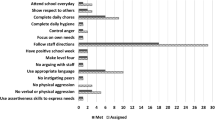Abstract
The effects of implementing the Teaching-Family Model in two community-based group homes were assessed through a series of pre-post measures. Data analysis indicates substantial positive change in youth social skills, program quality, youth and staff satisfaction levels, social climate, and staff accountability for care of the children.
Similar content being viewed by others
References
Baron, R., Cunningham, P., Palma, L., & Phillips, E.Family and community living skills curriculum. Boys Town, NE: Father Flanagan's Boys' Home, 1976.
Braukman, C.J., & Fixsen, D.L. Behavior modification with delinquents. In M. Hersen (Ed.),Progress in behavior modification. New York: Academic Press, 1975.
Evans, J., Dowd, T., Schneider, K., Wallace, E., Fixsen, D., & Phillips, E.Evaluation of the Boys Town youth care department. Boys Town, NE: Father Flanagan's Boys' Home, 1976.
Fixsen, D.L. Teaching-Family ideal: Scoring procedure for the COPES. Unpublished manuscript. Boys Town, NE: Father Flanagan's Boys' Home, 1979.
Ichinose, C., Schneider, K., & Fixsen, D. Standard operating procedures: Minor evaluation. Unpublished manuscript. Boys Town, NE: Father Flanagan's Boys' Home, 1978.
Koshel, J. Deinstitutionalization—delinquent children. Washington, D.C.: The Urban Institute, 1973.
Martin, H.P.Treatment for abused and neglected children. Washington, D.C.: U.S. Department of Health, Education and Welfare, DHEW Publication No. (OHDS) 79-30199, 1979.
Moos, R.Community Oriented Programs Environment Scale Manual. Palo Alto, CA: Consulting Psychological Press, 1974.
Phillips, E.L., Phillips, E.A., Fixsen, D.L., & Wolf, M.M.The Teaching-Family handbook. Lawrence, KS: University of Kansas (Achievement Place Project). Printed by University of Kansas Printing Service, 1972 (Rev. Ed., 1974).
Phillips, L., Phillips, A., Fixsen, D., & Wolf, M.The Teaching-Family handbook. Lawrence, KS: University of Kansas Printing Service, 1972.
Schneider, K., & Fixsen, D.Staff Accountability Scale. Boys Town, NE: Father Flanagan's Boys' Home, 1978.
Shah, S.A. Preparation for release and community follow-up. In H.C. Cohen (Ed.),Procedures for the establishment of educational environments. Silver Spring, MD: Institute for Behavioral Research; Educational Facility Press, 1968.
Shah, S.A. A behavioral approach to out-patient treatment of offenders. In H.C. Rickard (Ed.),Unique programs in behavior readjustment. Oxford: Pergamon, 1970.
True, L.Problems in evaluation design. Washington, D.C.: Evaluation and Program Implementation Division, United States Office of Management and Budget, 1976.
Webb, E., Campbell, D., Schwartz, R., & Sechrest, L.Unobtrusive measures: Nonreaction research in the social sciences. Chicago: Rand McNally and Company, 1971.
Author information
Authors and Affiliations
Additional information
Requests for reprints, samples of the “Staff Accountability Scale,” and other forms or the questionnaires in this study should be addressed to Kurt Scheider at The Maryville Academy, 1150 North River Road, Des Plaines, IL 60016
Rights and permissions
About this article
Cite this article
Schneider, K., Kinlow, M.R., Galloway, A.N. et al. An analysis of the effects of implementing the teaching-family model in two community-based group homes. Child Youth Care Forum 11, 298–311 (1982). https://doi.org/10.1007/BF01116209
Issue Date:
DOI: https://doi.org/10.1007/BF01116209



